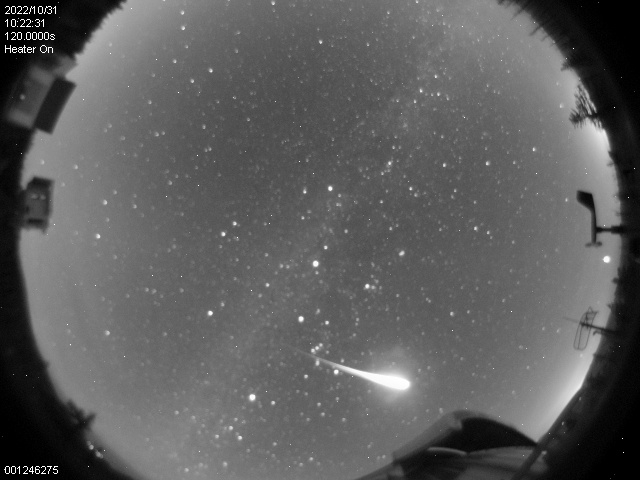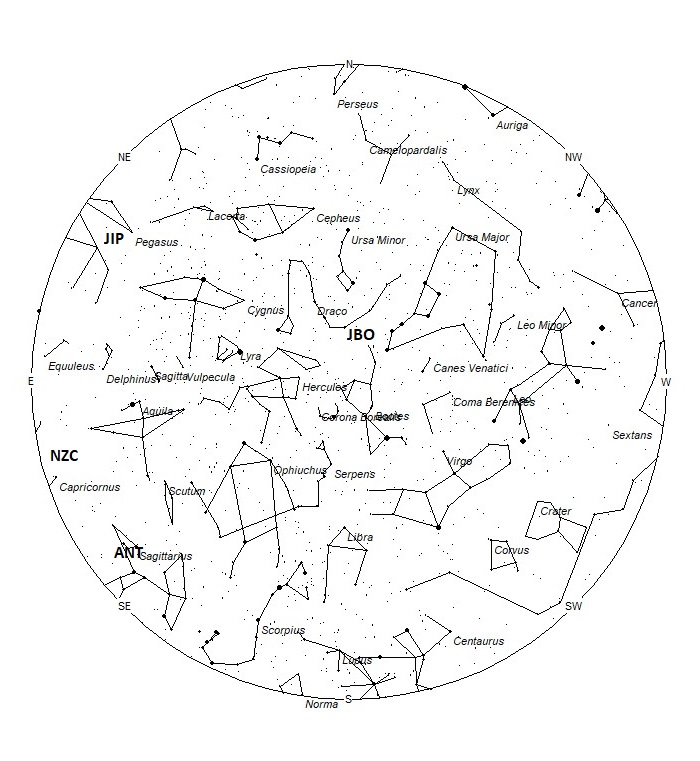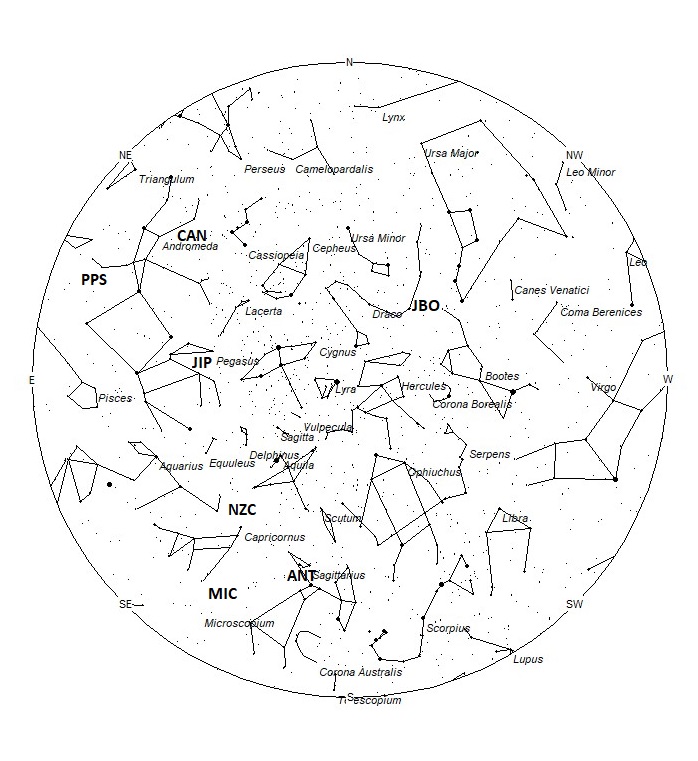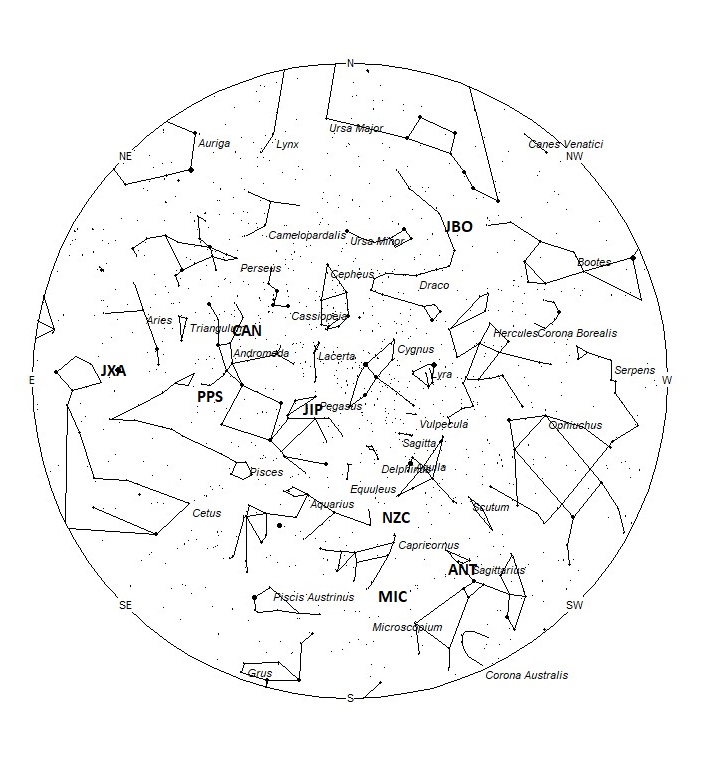
During this period, the moon reaches its first quarter phase on Monday June 26th. At that time, it will lie 90 degrees east of the sun and will set near 01:00 local daylight saving time (LDST). As the week progresses the gibbous moon will enter the morning sky and will begin to interfere with meteor observing during the more active morning hours. The estimated total hourly rates for evening observers this week should be near 2 as seen from mid-northern latitudes (45N) and 3 as seen from tropical southern locations (25S) For morning observers, the estimated total hourly rates should be near 9 as seen from mid-northern latitudes (45N) and 11 as seen from tropical southern locations (25S). The actual rates seen will also depend on factors such as personal light and motion perception, local weather conditions, alertness, and experience in watching meteor activity. Evening rates are reduced due to interfering moonlight. Note that the hourly rates listed below are estimates as viewed from dark sky sites away from urban light sources. Observers viewing from urban areas will see less activity as only the brighter meteors will be visible from such locations.
The radiant (the area of the sky where meteors appear to shoot from) positions and rates listed below are exact for Saturday night/Sunday morning June 24/25. These positions do not change greatly day to day so the listed coordinates may be used during this entire period. Most star atlases (available at science stores and planetariums) will provide maps with grid lines of the celestial coordinates so that you may find out exactly where these positions are located in the sky. I have also included charts of the sky that display the radiant positions for evening, midnight, and morning. The center of each chart is the sky directly overhead at the appropriate hour. These charts are oriented for facing south but can be used for any direction by rotating the charts to the desired direction. A planisphere or computer planetarium program is also useful in showing the sky at any time of night on any date of the year. Activity from each radiant is best seen when it is positioned highest in the sky, either due north or south along the meridian, depending on your latitude. It must be remembered that meteor activity is rarely seen at its radiant position. Rather they shoot outwards from the radiant, so it is best to center your field of view so that the radiant lies at the edge and not the center. Viewing there will allow you to easily trace the path of each meteor back to the radiant (if it is a shower member) or in another direction if it is sporadic. Meteor activity is not seen from radiants that are located far below the horizon. The positions below are listed in a west to east manner in order of right ascension (celestial longitude). The positions listed first are located further west therefore are accessible earlier in the night while those listed further down the list rise later in the night.
These sources of meteoric activity are expected to be active this week.
.
The June Bootids (JBO) are active from June 25-29 with maximum activity occurring on the 27th. At maximum the radiant is located at 14:52 (223) +48. This position lies in northwestern Bootes, 15 degrees east of the 2nd magnitude star known as Alkaid (Eta Ursae Majoris). This radiant is best placed in the evening sky just as the sky becomes dark. Observers in the northern hemisphere have a distinct advantage over those located south of the equator as the radiant lies much higher in the evening sky. No matter your location, little activity is expected from this source. With an entry velocity of 14 km/sec., the average June Bootid meteor would be of very slow velocity.
The center of the large Anthelion (ANT) radiant is currently located at 19:04 (286) -23. This position lies in north-central Sagittarius, 1 degree south of the 4th magnitude star known as omicron Sagittarii A. Due to the large size of this radiant, Anthelion activity may also appear from southeastern Scutum as well as Sagittarius. This radiant is best placed near 0200 LDST, when it lies on the meridian and is located highest in the sky. Rates at this time should be near 1 per hour as seen from the northern hemisphere and 2 per hour as seen from south of the equator. With an entry velocity of 30 km/sec., the average Anthelion meteor would be of slow velocity.
The Northern June Aquilids (NZC) were discovered by Zdenek Sekanina in 1976. These meteors are active from June 26 through July 22 with maximum activity occurring on July 15. The radiant is currently located at 20:14 (304) -07. This area of the sky is located in southern Aquila, 5 degrees north of the double star known as alpha Capricornii. This radiant is best placed near 0300 LDST, when it lies on the meridian and is located highest in the sky. Hourly rates at this time should be less than 1 no matter your location. With an entry velocity of 40 km/sec., the average meteor from this source would be of medium-slow velocity. An interesting fact about this source is that it may be related to the Northern delta Aquariids of August. Where and when this source ends coincides with the start and position of the Northern delta Aquariids.
The Microscopiids (MIC) were discovered by G. Gartrell and W. G. Elford, in their study of Southern Hemisphere meteor streams. This stream is active from June 25 through July 16 with maximum activity occurring on July 6. The radiant is currently located at 20:32 (308) -28. This area of the sky is located on the Capricornus/Microscopium border, 5 degrees southwest of the 4th magnitude star known as omega Capricornii. This radiant is best placed near 0300 LDST, when it lies on the meridian and is located highest in the sky. Hourly rates at this time should be less than 1 no matter your location. With an entry velocity of 40 km/sec., the average meteor from this source would be of medium-slow velocity. This shower is synonymous with the Southern June Aquilids (SZC).
The June iota Pegasids (JIP) are only active for 48 hours with maximum activity expected to occur near 23:00 Universal Time on June 25th. This timing favors Asian longitudes as the radiant will lie above the horizon in a dark sky at this time. The radiant lies at 22:06 (332) +29, which places it in northwestern Pegasus, 4 degrees north of the 4th magnitude star known as iota Pegasi Aa. This area of the sky lies highest in the northeastern sky during the last hour prior to dawn. With an entry velocity of 59km/sec., these meteors are swift.
The phi Piscids (PPS) have been found to be comprised of two components with separate activity periods. Component A is active from June 13 through July 5 with maximum activity occurring on June 25th. Current rates are expected to be near 1 meteor per hour just before dawn. The position of the radiant lies near 00:40 (010) +21. This position lies in northern Pisces, near the faint star known as 56 Piscium. The 4th magnitude star known as eta Andromedae also lies 4 degrees to the northeast. This area of the sky lies highest in the northeastern sky during the last hour prior to dawn. With an entry velocity of 67km/sec., these meteors are swift.
The c-Andromedids (CAN) were discovered by Sirko Molau and Juergen Rendtel using video data from the IMO network. Activity from this source is seen from June 21 through July 28 with maximum activity occurring on July 12. The radiant currently lies at 01:00 (015) +43, which places it in central Andromeda, 5 degrees northeast of the Great Andromeda Galaxy, which is visible to the naked eye as a small oval cloud. This area of the sky is best seen during the last dark hour before dawn when the radiant lies highest in the northern sky. Observers in the northern hemisphere are better situated to view this activity as the radiant rises much higher in the sky before dawn compared to southern latitudes. Current rates would be less than 1 per hour no matter your location. With an entry velocity of 57 km/sec., the average meteor from this source would be of swift velocity.
The July chi Arietids (JXA) were discovered by two investigating teams in Europe using video data from European video Meteor Network Database (EDMOND), SonotaCo, 2013; and CMN, 2013. Activity from this stream is seen from June 26 through July 22 with maximum activity occurring on July 7. The radiant currently lies at 01:33 (023) +03, which places it in southeastern Pisces near the brilliant planet Jupiter. This area of the sky is best seen during the last dark hour before dawn when the radiant lies highest in a dark sky. Current rates are expected to be less than 1 no matter your location. With an entry velocity of 68 km/sec., the average meteor from this source would be of swift velocity.
As seen from the mid-northern hemisphere (45N) one would expect to see approximately 7 sporadic meteors per hour during the last hour before dawn as seen from rural observing sites. Evening rates would be near 1 per hour. As seen from the tropical southern latitudes (25S), morning rates would be near 8 per hour as seen from rural observing sites and 2 per hour during the evening hours. Locations between these two extremes would see activity between the listed figures. Evening rates are reduced due to moonlight.
You can keep track of the activity of these meteor showers as well as those beyond the limits of visual observing by visiting the NASA Meteor Shower Portal. You can move the sky globe to see different areas of the sky. Colored dots indicate shower meteors while white dots indicate sporadic (random) activity. The large orange disk indicates the position of the sun so little activity will be seen in that area of the sky.
The list below offers the information in tabular form of the showers that I feel are within reach of the visual observer to discern. Hourly rates are often less than 1 but noting parameters such as the radiant distance and the elevation of each meteor, one can compute the probability of shower association. Most showers discovered by video means have rates less than 1 meteor per night away from maximum, so the showers listed in these articles are not as weak as they seem. Rates and positions are exact for Saturday night/Sunday morning except where noted in the shower descriptions.
| SHOWER | DATE OF MAXIMUM ACTIVITY |
CELESTIAL POSITION | ENTRY VELOCITY | CULMINATION | HOURLY RATE | CLASS |
| RA (RA in Deg.) DEC | Km/Sec | Local Daylight Saving Time | North-South | |||
| June Bootids (JBO) | Jun 27 | 14:52 (223) +48 | 14 | 22:00 | <1 – <1 | III |
| Anthelion (ANT) | – | 19:04 (286) -23 | 30 | 02:00 | 1 – 2 | II |
| Northern June Aquilids (NZC) | Jul 15 | 20:14 (304) -07 | 40 | 03:00 | <1 – <1 | IV |
| Microscopiids (MIC) | Jul 06 | 20:32 (308) -28 | 40 | 03:00 | <1 – <1 | IV |
| June iota Pegasids (JIP) | Jun 25 | 22:06 (332) +29 | 58 | 05:00 | <1 – <1 | IV |
| phi Piscids (PPS) | Jun 25 | 00:40 (010) +21 | 67 | 07:00 | 1 – 1 | IV |
| c-Andromedids (CAN) | Jul 12 | 01:00 (015) +43 | 56 | 07:00 | <1 – <1 | IV |
| July chi Arietids (JXA) | Jul 07 | 01:33 (023) +03 | 68 | 08:00 | <1 – <1 | IV |
Class Explanation: A scale to group meteor showers by their intensity:
- Class I: the strongest annual showers with Zenith Hourly Rates normally ten or better.
- Class II: reliable minor showers with ZHR’s normally two to ten.
- Class III: showers that do not provide annual activity. These showers are rarely active yet have the potential to produce a major display on occasion.
- Class IV: weak minor showers with ZHR’s rarely exceeding two. The study of these showers is best left to experienced observers who use plotting and angular velocity estimates to determine shower association. These weak showers are also good targets for video and photographic work. Observers with less experience are urged to limit their shower associations to showers with a rating of I to III.
 American Meteor Society
American Meteor Society


